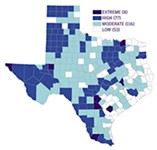Passionate Pioneers
By Katherine Gregor, Fri., Oct. 20, 2006
In organizing the annual symposium, the Wildflower Center and conservation-development program director Steve Windhager have led the state in bringing attention to the cause. "Conservation development is a way to use market forces to preserve portions of Texas' rich natural resources. In some cases, it will be the only way we are able to preserve any significant open space," said Windhager. "This is not the perfect solution everywhere, but it should be one of the tools conservationists use."
Chris Allen, the landowner-developer of the Woodson Place in northeast Texas, and Harold Teasdale, developer of Jackson Meadow in Minnesota, told similar tales of passion mixed with frustration. Both showed beautiful photographs of their developments and spoke with pride about the land they're conserving and the principled communities they're creating. Both also emphasized how teeth-gnashingly difficult it has been to pioneer and fight the status quo with an unproven real estate product.
Conservation developers work evangelically to educate lenders, site planners, home-builders, appraisers, real estate agents, land trusts, and finally home-buyers about the value of the approach – a process that can take many years. (Teasdale says he was turned down by 20 banks before finding a willing lender.) If green building practices are followed – Woodson Place homes are built to Austin Energy's highest five-star rating standard, for example – whole construction teams must become converts to new ideals and techniques. Often the greatest educational challenge lies in the public sector – with the municipalities, counties, and states that have jurisdiction over the land being developed. Because a conservation development doesn't fit the conventional mold – which beyond inflexible construction traditions, often presumes quick financial turnover – existing ordinances and regulations can prove an insurmountable roadblock. Consultant Joe Lessard spoke on how this problem is being addressed in his work with a new ordinance in Travis County.
Karen Ford, who is running for Hays Co. Commissioner in Precinct 4, was among the participants in a half-day, hands-on CD design charrette at the symposium. She reported that in Hays County, the subdivision rules are currently in review through a stakeholder process: "The fact is, we are going to continue to experience population growth in this area, and we must work toward responsible growth in any way we can. I do believe conservation development could be one good solution for northern Hays County. Preserving open space and natural areas will be critical to water-quality protection and sustainable groundwater recharge. I see CD as a growth-management tool, not a growth-limiting tool."
Visit www.wildflower.org, and search "conservation development" to read about the symposium, view related articles, register to receive CD resources and updates, and link to model developments nationwide.
Got something to say on the subject? Send a letter to the editor.








